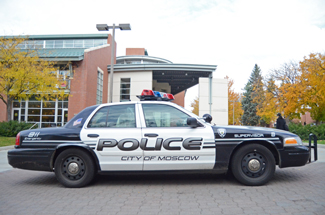UI Security and Fire Safety Report indicates lower crime rates on campus in 2013
Crime statistics on the University of Idaho campus are down across the board, according to the 2014 Security and Fire Safety Report, released this month by the UI Office of Public Safety and Security.

Nathan Romans | Argonaut
A Moscow Police Department police car sits in front of the Idaho Commons Thursday afternoon. The Office of Public Safety and Security recently released its Annual Security and Fire Safety Report, indicating a decrease in crime.
The report is put out annually in accordance with the Jeanne Clery Disclosure of Campus Security Policy and Campus Crime Statistics Act, better known as the Clery Act. The purpose of the Clery Act is to make crime statistics on college campuses readily transparent to students, parents and community members. The report outlines the crime statistics for the Moscow campus in calendar year 2013.
According to the report, only one crime statistic increased in 2013, liquor law arrests, which saw an increase from 41 arrests in 2012 to 46 arrests last year.
While liquor law arrests may have increased, liquor law violations referred for disciplinary action at UI were down from 228 in 2012 to 146 in 2013. Drug law arrests were also down, from 33 to 25. Most of the drug violations were in the residence halls, said Lt. David Lehmitz of the Moscow Police Department.
Also reported were incidents of dating violence, domestic violence and stalking — a new addition to the report in 2013 so data from previous years is unavailable. According to the report, there were no reported incidents of dating or domestic violence and four incidents of reported stalking.
Lehmitz said the decreased crime in 2013 didn’t surprise him and seemed in line with his observations around campus last year.
“(Crime) does seem like it’s been down,” he said. “We haven’t written as many alcohol violations, we’ve seen none of the fights or incidents of vandalism we’ve seen in the past.”
Lehmitz said UI has put a lot of work into safety programs over the past few years, including the Katy Benoit Safety Week, Green Dot, I’ve Got Your Back Campaign and many other programs centered on safe alcohol consumption, dating violence and stalking awareness.
Lehmitz said he suspects these awareness and encouragement efforts are responsible for the lower crime rates.
“It’s easier to get information to those individuals,” he said. “We encourage people to come forward and use the resources that the university offers. This year, we did have a lot of people come forward to report crimes as opposed to any other years.”
According to Matt Dorschel, executive director of the Office of Public Safety and Security, his office is happy to see lower crime statistics, but the numbers don’t necessarily indicate local crime has decreased.

Nathan Romans | Argonaut
“I don’t like to draw too many conclusions (from the numbers) — it kind of depends on the category,” he said.
For example, Dorschel said, in the case of alcohol and drug abuse violations, higher numbers may mean law enforcement is simply doing a better job. In the case of some violent crimes, especially those involving sexual abuse, Dorschel said the lower numbers may indicate fewer people came forward to report the crimes.
Dorschel said the numbers in 2013’s report reaffirmed what many community members already know: Moscow is a relatively safe place to be.
“It’s a small town, people know one another and it’s somewhat isolated from big cities and the problems that happen there,” Dorschel said. “That’s what it is about Moscow and UI that people are drawn to — people are engaged in everything, and parents in the community are engaged in ensuring their children and other children are safe, and there’s a lot of interest in making sure Moscow stays that way.”
Hannah Shirley can be reached at [email protected]
